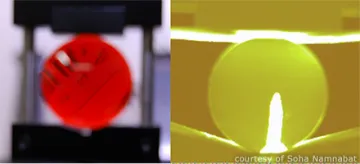Another Wavelength: Soha Namnabat

Summer break may have cleared the classrooms, but students are still roaming the halls and staffing the labs. This month on Another Wavelength, we caught up with third-year Ph.D. student Soha Namnabat, who does research with Robert A. Norwood. Though he was born in Texas, Soha spent much of his young life in his parents' home country, Iran, before moving back to the U.S. for grad school.
What brought you to optics?
During my school years I got very interested in astronomy, and this brought me into physics. Later I realized that optics is very interesting and related to astronomy – and one can make money too! So I decided to study optics.

Who would you call your science hero?
I have a lot of heroes in science, but one of them is Avicenna, or Ibn-Sīnā. He was a famous Iranian scientist in the Islamic golden ages and contributed to medicine and philosophy. His brightness and wisdom, especially in his childhood, was always an inspiration for me. He was always ahead of his time and his age.
Describe your research in 20 words or fewer.
Seeking novel materials to improve functionalities for photonic devices.
Describe your research in 200 words or fewer.
I work in Dr. Norwood's group, and my main focus is fabricating optical integrated circuits with a variety of novel materials. My colleagues and I are investigating materials that not only enable us to guide light but also control light in a new way. For example, we make modulators that use special electro-optic polymers that allow us to convert electric signals into optical signals. These devices find a lot of applications that enable us to transmit data with higher data rates and low energy consumption.
A similar project I am working on is building a platform to reduce thermal sensitivity in these optical devices. Like in electronic circuits, temperature fluctuations have a negative effect on the performance of optical devices, especially in microring resonators, which seem to be the future in silicon photonics. Thus my research is to identify materials that help me reduce the peak resonance shifts due to heat and stabilize the peak wavelength in a passive fashion.

Left: An Air Force target imaged through the sulfur copolymer molded lens. Right: An image from a solder iron tip taken through the polymer lens using a mid-infrared camera.
Finally, one of my other interesting projects is studying the optical behavior of a new polymer that our colleague Dr. Jeff Pyun's group made in the chemistry department. They developed a new method to copolymerize sulfur in large ratios and large scales. Our investigations lead to the discovery that the copolymer’s transmission spectrum covers some parts from the visible up to the mid-infrared region. Most other polymers can’t transmit in the midwave-infrared.
Name three neat facts about you.
- I love traditional Iranian music and play tonbak (which looks like this and sounds like this).
- I enjoy hiking a lot and have climbed the highest peaks in Iran, Damavand (18,410 feet) and Sabalan (15,784 feet).
- My lasagnas are one of the best things I cook!
